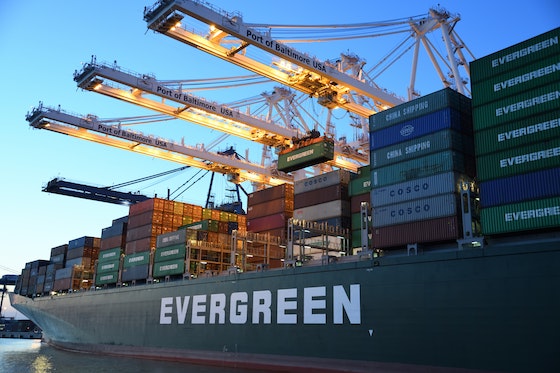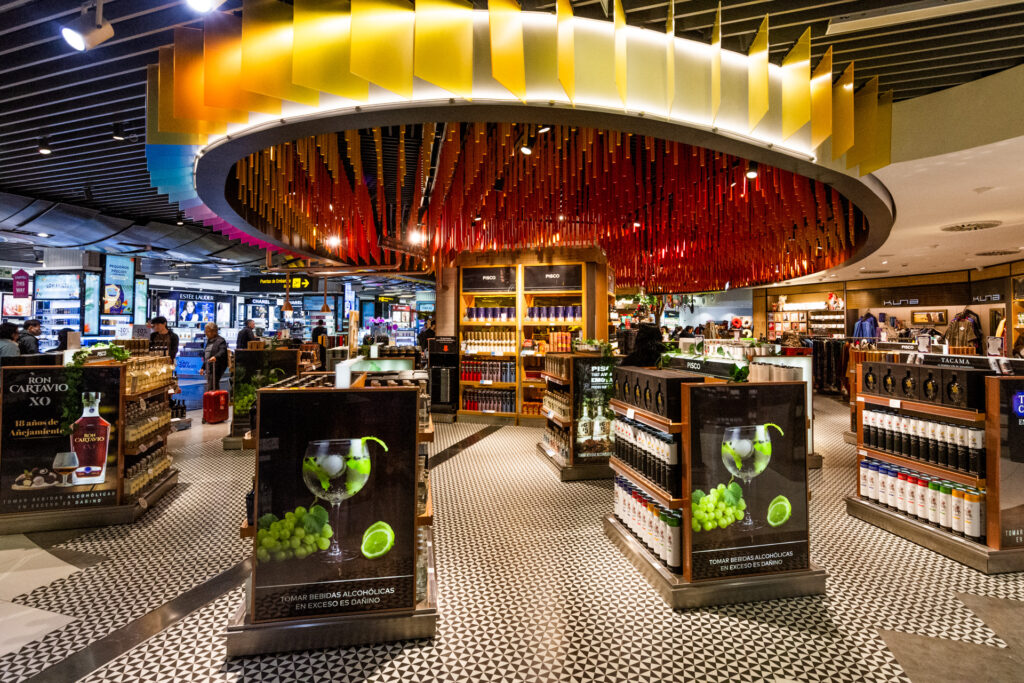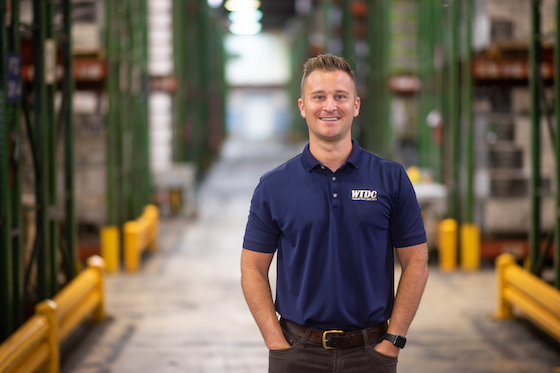Keeping shelves restocked with wines and spirits has been a constant challenge for operators in the Americas. Joe Bates reports on a complex, post-COVID-19 issue.
It is the post-pandemic business headache that won’t go away. The global supply-chain crisis has affected almost every industry, the duty free liquor business included. A complex network of interconnected factors is to blame–an unexpectedly strong surge in consumer demand after COVID-19, a shortage of shipping containers, port congestion, labor shortages, extreme weather events, raw material shortages and the war in Ukraine have all played their damaging part.
The just-in-time business models favored by modern retailers, which in normal times avoid stockpiling products to keep costs low and boost profitability, have buckled under the strain. Since international travel rebounded after COVID, duty free retailers in the Americas have suffered repeated out-of-stocks, rising prices, longer delivery wait times and an intensified level of uncertainty.
“Globally, we suffered from a crisis at the supply chain and procurement level,” admits Cyril Letocart, CEO Lagardère Travel Retail Peru, which started a 13-year duty free concession at Lima airport in January last year. “On the spirits and wine side, the impact was huge due to a lack of raw materials such as glass and carton boxes. To compensate potential loss due to a lack of products, we had to adapt quickly and this has been very tough as we were still in a start-up phase.”
Canadian border operators highlight local craft products
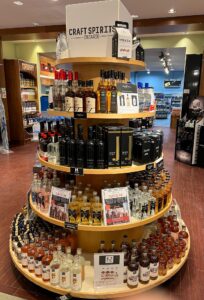
Ontario border duty free operators turned to local crafts spirits to fill the gap left by supply chain issues as seen in this display at Ambassador Duty Free.
Long-suffering Canadian border store retailers have also run into supply-chain issues now that they are open for business after most Canadian border COVID-19 entry restrictions were lifted in October last year. “As business ramped up in 2022, we found new issues to deal with– primarily, the supply chain was disrupted to such a degree that many products were not available or short-shipped,” recalls Steve Richardson, general manager of Ontario- based Niagara Duty Free. “As the year went on, it became clear this problem was going to take longer to correct itself than anticipated. Some categories suffered immensely such as fragrance, cosmetics and liquor.
“We have very little opportunity to influence fragrance and cosmetic sales by bringing in local brands which are not recognized by the international traveler,” he adds. “However, in our liquor department, we have had great success in supplementing the brands we offer. The consumer is more open to entertaining offerings from the smaller distilleries and the Niagara Region has seen many new local distillers come online over the last few years.”
Fellow Ontario border operator Ambassador Duty Free Store liquor & tobacco category manager Mike Maskery reports supply-chain issues have eased in the first quarter of 2023 but there are still problems with both domestic and imported lines. “There are lots of products on allocation,” he admits. “The Ontario duty free market is such a small market compared to the rest of the world.”
Like Niagara Duty Free, Ambassador Duty Free Store has stepped up its focus on local craft distilleries, negotiating excellent pricing with a dozen Ontario companies such as Vodkow cream liqueur, Jaan Canadian whisky and Ginslinger craft gin. “We put a special gondola in the store for these, along with putting the products in their regular sections around the store,” Maskery reports.
International Shoppes rethinks purchasing strategy
In the U.S., Scott Halpern, president of International Shoppes, which operates duty free and speciality stores at major U.S. airports such as New York JFK, Boston Logan and George Bush Intercontinental, admits the company has had supply issues with “all vendors across the board” in terms of supply. Retail prices have risen but the increases have come from the suppliers rather than International Shoppes, he reveals.
Halpern says the crisis has made the retailer rethink its purchasing strategy to ensure it was offering the most complete assortment for its customers as possible. “If one brand was out, we quickly overcompensated on another to keep a healthy balance in our stores,” he explains. “I think we learned a lot throughout the last three years about being a nimble company and adapting to change. We are well situated to tackle any future issues should they come our industry’s way.”
Lagardère Travel Retail Peru also had to be proactive to avoid shortages, the liquor category accounting for a substantial 20% of total sales at Lima airport. “Since the opening of our duty free shops in Peru, our first priority has been to stabilize the supply chain and find the best freight forwarders and shipping company to support our growth,” Letocart maintains. “The idea was to be as flexible and agile as possible to optimize costs. In addition, we have been training our teams to do the maximum to anticipate orders, improve forecasts and make sure that the service level agreement with our suppliers was respected.
“In terms of relationships with suppliers, we are constantly in communication with them to look for solutions to increase service rate but also to reduce lead time,” he adds. “We had to review our order planning to find the perfect fit between order frequency and logistics costs. Now that we have some historical sales data, our key objective for 2023 will be to deploy our automatized forecasting tool.”
Distributors and suppliers share their experiences
Drinks suppliers and distributors also acknowledge the scale of the problems they have been facing since travel retail restarted. “Because of supply chain issues, we’ve had to plan much further in advance, and increase our inventory in our warehouses in Miami and overseas,” says John McDonnell, managing director, international, at Tito’s Handmade Vodka.
“Booking space on trucks and ships has been a challenge for every supplier. One of our largest supply-chain challenges has been our non-refillable bottle.”
Mauricio De Tuya, cluster director America for Spanish wine and spirits supplier Zamora Group, the producer of Licor 43, says 2022 was a “nightmare” for the company’s supply-chain team. “They faced challenges at every turn; severe COGS [costs of goods sold] increases were their day-to-day battles. We intend to simplify the business by reducing the list of SKU’s available. At the end of the day, the consumer will suffer a narrower range of products…although it may be a good time to simplify the business too.”
Despite the price increases De Tuya insists Zamora managed to maintain a high level of customer service during 2022. “We did not encounter any large delays or problems along the way. Our supply chain did an extraordinary job back then. 2023 is quite blurry so far. Of course, we have high expectations in regard to our supply and we believe things should improve and facilitate our standards. We did increase our lead times a little, but at the same time we pushed the long-term demand planning with our partners.”
Similarly, Americas-focused drinks distributor Monarq Group, whose broad portfolio of wines and spirits includes Champagne Bollinger, Cono Sur, Quintessential Brands, Gruppo Montenegro and Heineken, has also faced challenges despite enjoying booming sales last year. Managing director Robert de Monchy acknowledges ongoing supply shortages on some super- and ultra-premium lines, noting, for instance, that Bollinger Champagne has been on strict allocation for several years.
“Forecasting has become a key element of our business,” he explains. “The lead times are generally considerably longer than before and we have moved to larger inventories, maintaining a buffer to overcome any hurdles or delays with upcoming orders. This also means that free cash is more important than ever before. The financially stronger companies are in better shape to deal with these situations and will come out even stronger.
“We are currently introducing a number of wonderful new brands such as Uncle Nearest Premium America Whiskey, Drumshanbo Gunpowder Gin, Condesa Gin, Heavensake Sake and the world’s rarest Japanese single malt whisky, Shirakawa 1958,” he adds. “We are also making a strong push with Gosling’s Ginger Beer and Asahi Super Dry onboard the cruise ships.”
Finally, Brown-Forman VP managing director David Rodiek stresses the proactive steps the company has taken to tackle some of the key issues. These measures include collaborating with customers prioritizing the available inventory to strategic locations; exploring alternative bottle sizes when standard 1-litre sizes were not available; moving products to bonded warehouses closer to customers and restructuring orders to isolate constrained lines, so that available products could be shipped faster.
“Overall, we had to be agile and creative in proposing mitigation plans to support our customers,” says Rodiek. “Today, Brown-Forman’s supply situation has improved significantly, especially as of late 2022.”
How Carnival Cruise Line coped with the crisis
COVID-19 devastated the cruise industry but guest numbers have rebounded quickly since it was brought to a screeching halt in March 2020, reaching over 50% of pre-pandemic levels to total 13.9 million passengers in 2021 and forecast to grow by 12% over pre-COVID 2019 next year, according to leading global cruise industry trade group Cruise Lines International Association (CLIA).
Cruise ship logistics supply chains have always been uniquely complex and highly specialized. Cruise ships are effectively floating resorts which need to be resupplied during short port stops– suppliers and service providers have to align with these short turnaround times. According to Zachary Sulkes, senior director of beverage operations at Carnival Cruise Lines, the sudden restart of the cruise sector caught many drinks companies by surprise. Many suppliers were struggling to meet booming lockdown domestic markets and found it hard to switch to restocking the travel sector.
“Domestic markets were booming,” he recalls. “Bacardi had its best year ever right in the middle of the pandemic because the U.S. domestic market was doing so well. So, not a lot of people had safety stock for duty free… At the beginning, there was a lot of out-of-stocks, a lot of needing to switch bottle sizes. Typically, in duty free we use the liter size for the beverage pouring business, but we had to switch to 750ml or even 700ml, basically, whatever we could find in the world. It really was quite chaotic.”
There was also shipping challenges, Sulkes remembers. “If I needed some wines from Europe for my program because they had all gone bad because they’d just sat there in port storage during the pandemic and got warm. Say, I needed ten pallets of Italian wine; those pallets would normally take one to two months to ship. Now, they were taking anywhere from four to six. The ships started off without a lot of the products they were supposed to have.”
Sulkes says beer and spirits companies were quick to ramp up supplies, fearful that if Carnival had had to switch to another suppliers to fill a hole in its drinks program, it might not switch back. “If all of sudden I am going to switch my white rum from Bacardi to Flor de Caña, I am probably never going to go back. Once I find a partner that’s working for me, I am not going to switch back. Suppliers understood that, especially on the beer and spirits side, more so than wine where shipping delays were taking ages.”
The supply problems have eased but trying to avoid any future issues is challenging, according to Sulkes, as cruise ships typically only have space to stock two weeks’ worth of product for the bars and onboard shops. “We can’t really change what we do. As the product gets used, we order more.
“The one thing I have done from a pouring perspective is told the ships to carry more stock of the fast-moving items,” he adds. “So, raise the level of whatever are our top five fastest moving items. Make sure you have extra inventory of those. I’m okay if that means I have less of the slow-moving lines because of space concerns because we can’t ever run out of the fast-moving ones because they are the cash cows, the ones that make us the most money.”
Scotch whisky and transatlantic freight problems
Much of the focus on supply shortages facing duty free retailers in the Americas has focused on the high costs, delays and disruptions affecting sea freight crossing the Atlantic from Europe. Barbara Scott, operations director of Edinburgh-based Scotch whisky bottler and distribution specialist Youngs Spirits, is an expert in the Scotch whisky industry supply chain and well placed to comment on the current challenges facing cross-Atlantic trade which she notes are now slowly easing.
“As congestion across U.S. ports has continued to fall so to have transatlantic sea freight rates – some 7-8% in the last month and over 10% for the same period in 2022 but prices are still significantly higher than 2019 (as much as 200%),” she explains. “There is an expectation that rates will continue to drop but this is not a given. Concerns still remain in terms of congestion in southeast U.S. ports and Houston while uncertainty remains due to unresolved labor disputes between operators and port workers unions on the West coast. We have seen a shift in preference to ship to East coast and it will be interesting to see how long this will continue through 2023.”
Scott notes that the travel retail industry’s reliance on exclusives has left it particularly vulnerable to supply shortages. “Whisky distillers often market travel retail exclusives, which when travel was restricted, saw a marked decrease in production and sourcing of materials for these products resulting in a longer recovery period to supply. Opportunities now exist in this area as travel has opened up and gaps have appeared from the larger whisky distillers (though business travel is unlikely to return to pre-pandemic levels due to rise of online collaboration software).
“It will be interesting to understand the extent to which these gaps will remain in 2023 as demand and supply normalizes or whether the re-distributed allocated older aged single malts will continue to be exported to markets such as the Far East where they can command higher prices,” she adds.
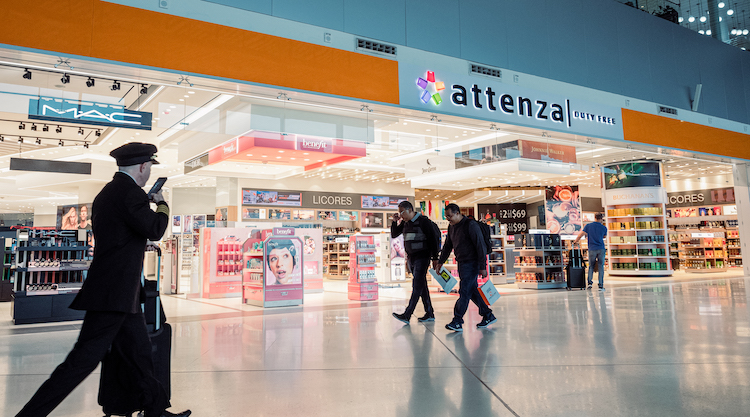
Motta Internacional’s Attenza Duty Free’s liquor supply has been improving, says Motta buyer Carlos Calvo.
A brightening outlook for 2023
Despite the ongoing supply challenges the duty free liquor business in the Americas is facing, it’s important to stress both suppliers and retailers report strong growth for last year and are upbeat about business prospects for 2023. “Our liquor business is performing very well overall as airport traffic improves by the day,” says Carlos Calvo, liquor buyer at Panama-based travel retailer Motta Internacional, whose Attenza Duty Free store chain extends to over 40 locations at airports and border stores in Panama, Ecuador, Nicaragua, El Salvador and Colombia.
“Supply has been improving, so we are expecting a good 2023,” Calvo adds. “Scotch whisky has been driving the category, and tequila sales have been increasing exponentially.”
Calvo’s comments are typical of a business moving in the right direction despite ongoing supply chain problems– indeed the IWSR Drinks Market Analysis has revealed that duty free spirits sales by value in the Americas already reached pre- pandemic levels in 2022 and are on course to match pre-COVID volumes by 2024.
Logistics provider WTDC reflects on supply-chain issues
Family-owned company WTDC has been in the logistics business for 46 years. The Miami-based business became PortMiami’s first operating Foreign Trade Zone (FTZ) in 2012. Since 2006, the company has been heavily involved in the bonded warehousing and transportation of drinks to duty free retailers in the Americas.
During the pandemic, WTDC president & CEO Sean P. Gazitúa says ocean freight prices peaked at almost 10 times their normal pre-pandemic levels. Pre-COVID, to ship a product from China to Miami might have cost around $2,000; now that price was $20,000.
“It was insane,” says Gazitúa. “Not only did the prices go up, the availability of bookings was also an issue too. If I did get the approved rate from my customer, then I would contact the steamship line and I would say, ‘Get me two containers’ and I found out that they aren’t going to be available for two months. I needed a next- week sailing.”
Gazitúa says freight prices have now dropped and supply-chain bottlenecks are easing. However, he says inflation has caused some of his customers to be cautious and to try to reduce costs wherever possible.
WTDC is moving with the times. The logistics business is becoming more dependent on digital technology, according to Gazitúa. “In the beginning, it was just an RF scanner, moving a pallet with a pallet ID from one location to another. Now with technology, we are trying to do electronic data interface when our customers’ systems and our systems communicate. Our customer service team is not focused on data entry all-day long. We provide a boutique, specialized service.”
Sustainability is also becoming a much more important aspect of WTDC’s operations. The company now prepares reports on carbon dioxide emissions for customers, detailing steps the company is taking to lower its carbon footprint such as using electric forklifts, installing new LED lights, new efficient air conditioners that use less electricity and installing a white roof to reflect the sun’s rays




